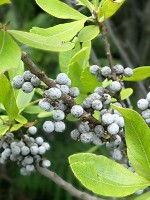Mon-Fri 9am - 5pm Mountain time
Garrington Chokecherry vs Northern Bayberry
Prunus virginiana Garrington
Myrica pensylvanica
NOT AVAILABLE THIS SEASON - MIGHT RETURN
NOT AVAILABLE THIS SEASON - MIGHT RETURN
Garrington Chokecherry is a self-fertile and rare chokecherry that is commonly used for commercial orchards. This highly prized selection is known for its heavy yields of large, reddish-black fruit that are easily harvested with an over row harvester.
Garrington Chokecherry is also commonly used for hedges and edible landscaping. This shrubs' chokecherries are commonly used in baking, preserves, wine, and jams or jellies.
Northern Bayberry makes an excellent hedge or feature shrub. It will retain its leaves in warmer climates but drops them in colder areas. They produce blue-grey berries that have a wax coating on them that can be used to make candles or soaps.
In colder hardiness zones the leaves turn an attractive orange to red colour in the fall, making it a striking addition to your landscape.
Northern Bayberry is native to Nova Scotia and tolerates both drought and wet conditions. It is also a nitrogen fixer that tolerates poor soil conditions.
Garrington Chokecherry Quick Facts
Northern Bayberry Quick Facts
Toxicity: Warning: The wax from bayberry fruit is considered toxic and may be carcinogenic.

